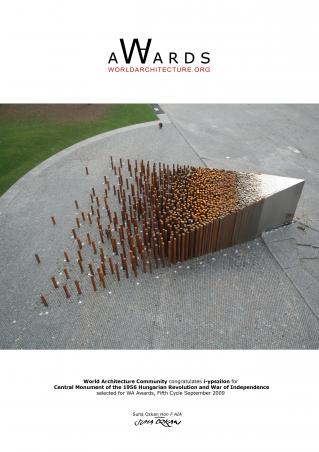By virtue of the Government Decision on the National Monument of the 1956 Hungarian Revolution and War of Independence, and the Mayor of Budapest jointly prepared the erection of the monument.
The plans of the Monument were selected in an international open competition. The independent international jury decided to reward seven plans. The winning plans were submitted by the group „i-ypszilon” (Tamás Emodi-Kiss architect, Kata György artist, Csaba Horváth artist, Tamás Papp architect).
The starting points of the design of the memorial were those well-known photos, which depict the undergraduates marching to the sculpture of Jozef Bem from the Polytechnic University, on October 23 1956. The wedge-like shape symbolizes the people going arm in arm, trusting each other, and the power of community.
The memorial stands at the border of the City Park. The base of it is a square, that evocates the contemporary streets, the “square of silence”, that gives an opportunity to personal, engrossed remembrance. The rustically corroded, man-sized, iron columns emerge from here, and it is possible to walk among them until the tierce of the work. The spectator can become a segment of the community, marked by the columns; can seek for the opportunity in himself, that led common men to heroism in 1956, and that is still a part of our humanness nowadays.
Moving forward along the axle of the work, the columns are located increasingly tighter, their material gradually brightens, they become higher and higher, when finally they unite by formulating a perfectly consistent, eight-meter tall, stainless high-allowy steel block. This wedge refracts the overlay of the Felvonulási street, referring to the force of the revolution, what appeared at this location also.
The monument commemorates to that unique moment, when the citizens of Hungary overcame their own individualities, in order to stand up as members of the united community, for the idea of freedom and independence. The monument does not wish to illustrate, but intends to make it possible for the spectators to imagine themselves living through those events of history, thus the remembrance should have an effect on the present days.
2005
2006
Central Monument of the 1956 Hungarian Revolution and War of Independence by Kata György in Hungary won the WA Award Cycle 5. Please find below the WA Award poster for this project.

Downloaded 936 times.
Favorited 11 times
.jpg)

.jpg)





.jpg)
.jpg)
.jpg)
